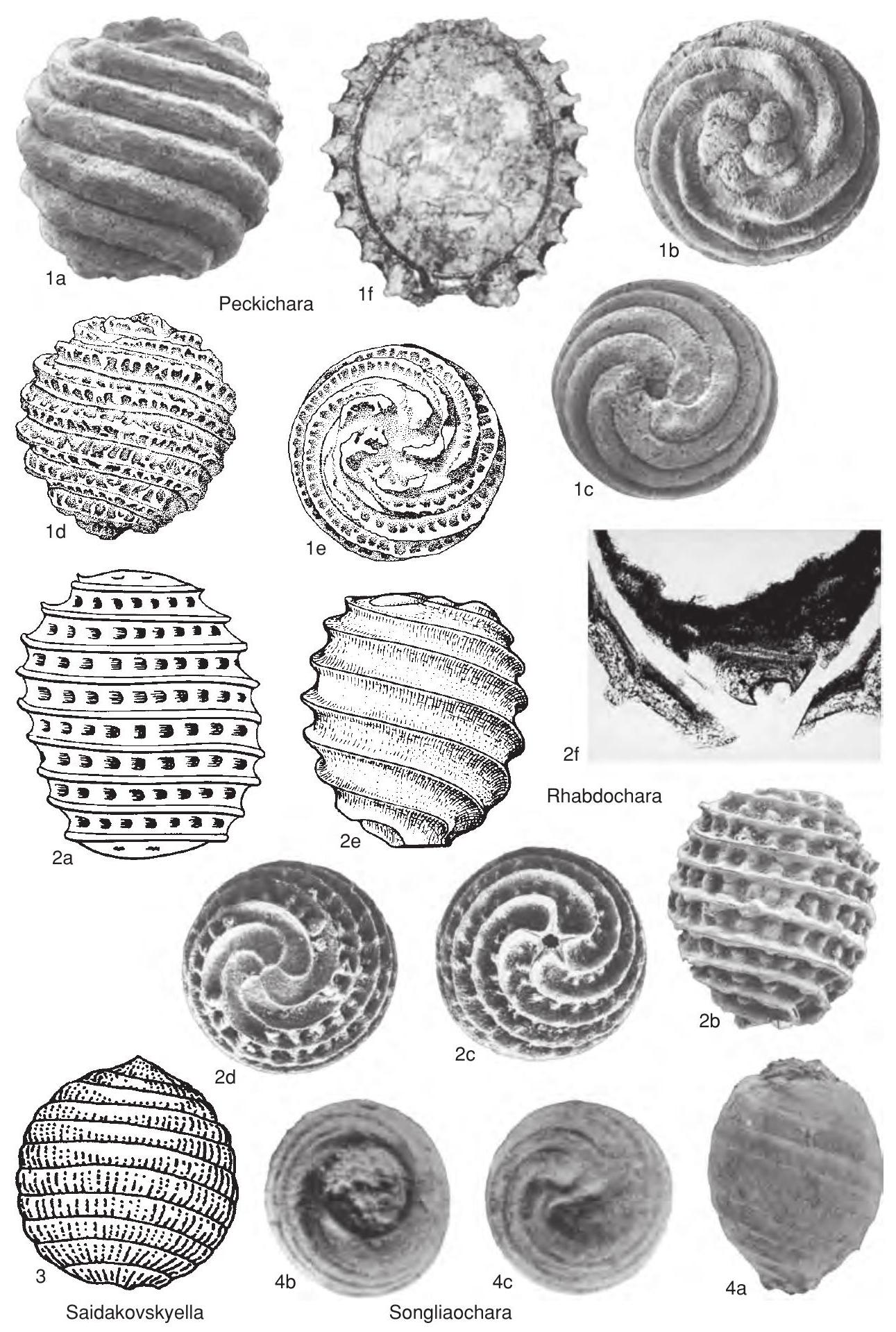Welcome to the Treatise on Invertebrate Paleontology!
Please enter a genera name to retrieve more information.

Rhabdochara
Classification
Phylum:
Charophyta
Class:
Charophyceae
Order:
Charales
Suborder:
Charineae
Family:
Characeae
Subfamily:
Charoideae
Formal Genus Name and Reference:
Rhabdochara Mädler, 1955, p. 299, emend., GRAMBAST, 1957, p. 357
Type Species:
Chara langeri ETTINGSHAUSEN, 1872, p. 162, pl. 1, 2-3, OD
Images
(Click to enlarge in a new window)
Fig. 73,2a-d. *R. langeri (Ettingshausen) Mädler, lower Miocene, a, lateral view, Slovenia, x40 (adapted from Ettingshausen, 1872, pl. I, 3), b, lateral view, France, x47 (Feist & Ringeade, 1977, pl. 23,9), c, basal view, France, C.536-9, d, apical view, France, C.536-8, ×40 (new).——Fig. 73,2e. R. stockmansi Grambast, lower Oligocene, France, lateral view, x50 (Grambast, 1957, text-fig. 6).-_ Fig. 73,2f. R. praelangeri CAStel, upper Oligocene, France, longitudinal section, basal part, x50 (Castel, 1967, pl. XX, 11).
Synonyms
Geographic Distribution
Europe (widespread), China
Age Range
Beginning Stage in Treatise Usage:
Paleogene (?lower Eocene, upper Eocene)
Beginning International Stage:
Ypresian
Fraction Up In Beginning Stage:
0
Beginning Date:
56
Ending Stage in Treatise Usage:
Neogene (Miocene)
Ending International Stage:
Messinian
Fraction Up In Ending Stage:
100
Ending Date:
5.34
Description
Apex psilocharoid, apical zone thin but convex, weakly marked apical nodules rarely present, general shape subprolate to ellipsoidal with summit truncated and base somewhat tapered, spirals generally concave, smooth or with transverse rods, basal plate conical and hollow, size variable. [iffers from Stephanochara and Lychnothamnus in lacking periapical depression and having strongly developed nodules, hollow basal plate, and ornamentation consisting of rods instead of tubercles.]
References
Museum or Author Information
Classification
Phylum:
Charophyta
Class:
Charophyceae
Order:
Charales
Suborder:
Charineae
Family:
Characeae
Subfamily:
Charoideae
Formal Genus Name and Reference:
Rhabdochara Mädler, 1955, p. 299, emend., GRAMBAST, 1957, p. 357
Type Species:
Chara langeri ETTINGSHAUSEN, 1872, p. 162, pl. 1, 2-3, OD
Images
(Click to enlarge in a new window)
Fig. 73,2a-d. *R. langeri (Ettingshausen) Mädler, lower Miocene, a, lateral view, Slovenia, x40 (adapted from Ettingshausen, 1872, pl. I, 3), b, lateral view, France, x47 (Feist & Ringeade, 1977, pl. 23,9), c, basal view, France, C.536-9, d, apical view, France, C.536-8, ×40 (new).——Fig. 73,2e. R. stockmansi Grambast, lower Oligocene, France, lateral view, x50 (Grambast, 1957, text-fig. 6).-_ Fig. 73,2f. R. praelangeri CAStel, upper Oligocene, France, longitudinal section, basal part, x50 (Castel, 1967, pl. XX, 11).
Synonyms
Geographic Distribution
Europe (widespread), China
Age Range
Beginning Stage in Treatise Usage:
Paleogene (?lower Eocene, upper Eocene)
Beginning International Stage:
Ypresian
Fraction Up In Beginning Stage:
0
Beginning Date:
56
Ending Stage in Treatise Usage:
Neogene (Miocene)
Ending International Stage:
Messinian
Fraction Up In Ending Stage:
100
Ending Date:
5.34
Description
Apex psilocharoid, apical zone thin but convex, weakly marked apical nodules rarely present, general shape subprolate to ellipsoidal with summit truncated and base somewhat tapered, spirals generally concave, smooth or with transverse rods, basal plate conical and hollow, size variable. [iffers from Stephanochara and Lychnothamnus in lacking periapical depression and having strongly developed nodules, hollow basal plate, and ornamentation consisting of rods instead of tubercles.]
